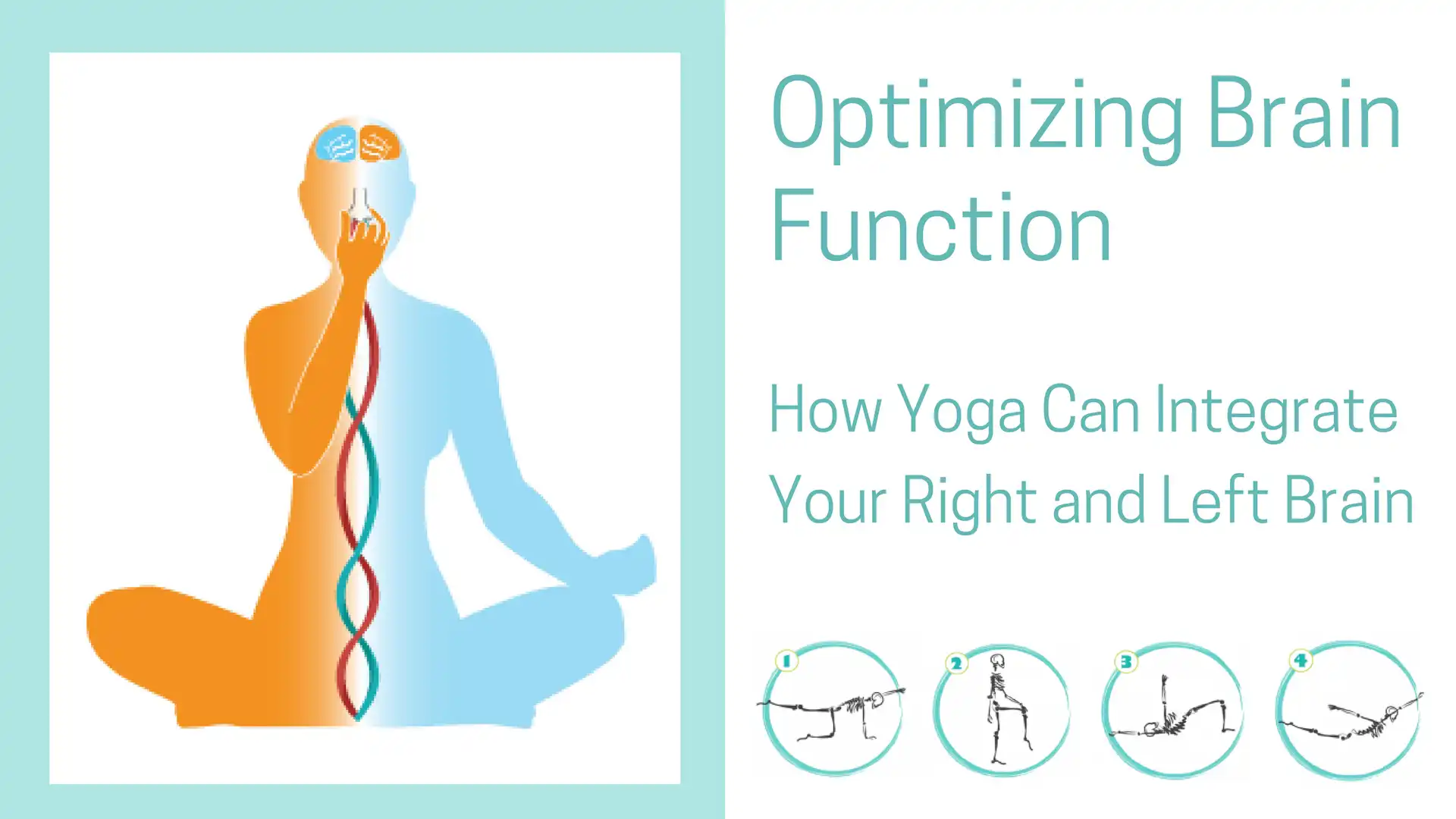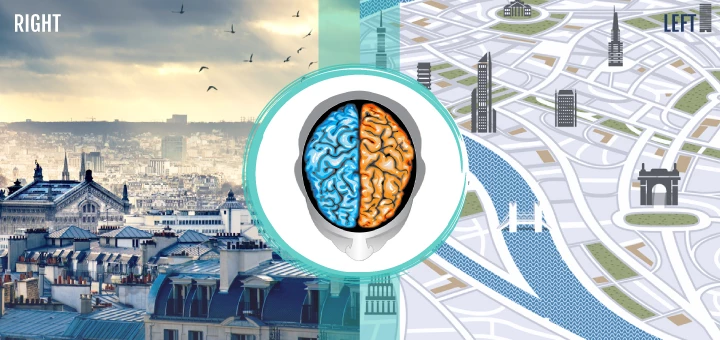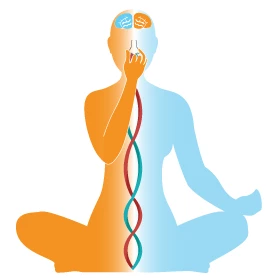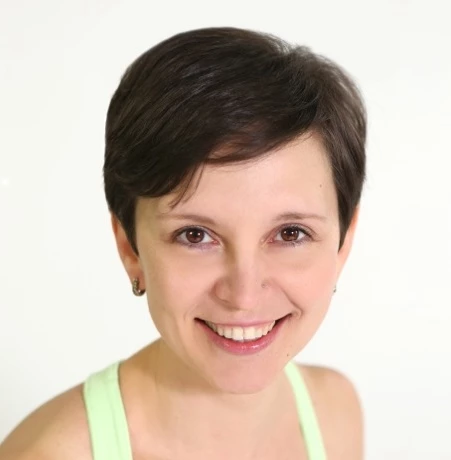Optimizing Brain Function: How Yoga Can Integrate Your Right and Left Brain

Throughout the day, we breathe predominantly through one or the other nostril. This is a natural process, called the “nasal cycle,” wherein our nostrils alternate being more congested. At times the left nostril is more congested, and at other times the right nostril is more congestion. So for example, when the left nostril is more congested, we breathe more through the right nostril, i.e., the right nostril is “dominant” during that period.
Scientists have discovered that when your right nostril is dominant, the EEG activity is greater in the left cerebral hemisphere (each hemisphere controls the opposite side of the body), and when the nostril dominance switches, so does the activity of the brain hemisphere.
Basically what they are saying is that in the course of the day one hemisphere becomes dominant and then another in a rhythmical fashion and it switches back and forth, and it is directly linked to the nasal cycle. This is called “alternating dominance of cerebral hemispheric activity.” So if you want to know which side of your brain is more active right now, check which nostril feels more open. If the left nostril is more open, then your right brain is dominant right now and vice versa.
That’s pretty fascinating, considering that our right and left hemispheres experience the world very differently. It seems that the scientific community had disposed of the popular idea of the right brain as the creative one and the left brain as the logical one; nothing in the brain is that simple. Instead, it is widely accepted that both sides of the brain are necessary to perform most tasks; they just handle them a bit differently.
Kara D. Federmeier, cognitive neuroscientist says: “It doesn’t seem feasible for the hemispheres to fully share information or to operate in a fully unified fashion. Moreover, in a lot of cases, keeping things separate is (literally!) the smarter way for the hemispheres to function. Dividing up tasks and allowing the hemispheres to work semi-independently and take different approaches to the same problem seems to be a good strategy for the brain … just as it often is in partnerships between people.”

How the Right and Left Brains See the World
It appears that the biggest difference between the hemispheres is the way they see the world. Our right hemisphere lives in the now and experiences each moment individually and every moment is vibrant with sensation. Think back to some of your more vivid memories—these are the snapshots in time made possible by the right hemisphere.
The right hemisphere sees the world as a whole, and is more connected to rhythm and flow. It prefers uniqueness and is involved more with new experiences, events, things, ideas while they are still fresh and original. It is more skilled at recognizing relationships between things and allows you to see the big picture. Ultimately, it is interested in understanding and experiencing the world.
Our left hemisphere, on the other hand, takes all those vibrant moments and strings them together in a linear fashion, organizing them into past, present, and future. The big picture perception is broken down into manageable and analyzable bits of data that are then compared and evaluated. The left brain is more involved with things that are familiar and known. It prefers to generalize.
The left hemisphere views a world more like a map or a model, which is a representation of the real thing. It defines the concept of “self” and keeps track of who you are, where you live, what your credentials are. That little voice that always compares yourself to others resides in the left hemisphere. Ultimately, the left hemisphere is interested in manipulating the world to your advantage.
How the Hemispheres Work Together
Both hemispheres are involved in most mental processes and information is constantly being sent back and forth between them. And while there is no such thing as “hemispheric personality” (right-brained or left-brained), there is evidence that for some kinds of activities we consistently favor one hemisphere over another. Which one we prefer for which activity will depend on the person.
Iain McGilchrist explains: “On those occasions where the “wrong” hemisphere does get in there first, however, and starts to take control … it will most probably continue to trump the other hemisphere, even if the other hemisphere would have been a better choice at the outset—possibly because the time costs of sharing or transferring control are greater then the costs of continuing with the current arrangement.”[1]
So basically, if your right hemisphere would be better at a certain task, but the left one gets there first (for example, if it was more active at that moment), the left one will continue to run the show and give you a different experience than the right one would. Iain McGilchrist goes even further: “The hemispheres need to cooperate, but I believe they are in fact involved in a sort of power struggle.”[1]
The cooperation between the right and left brains is essential for us to learn better, function more intelligently and become proficient in anything. Whatever it is you are engaged in—reading, writing, music, art, sports—each hemisphere has something important to contribute for you to have access to both technique and inspiration.
David Siegel and Tina Payne Bryson write: “The brain has two sides for a reason: with each side having specialized functions, we can achieve more complex goals and carry out more intricate, sophisticated tasks. Significant problems arise when the two sides of our brain are not integrated and we end up coming at our experiences primarily from one side or the other. Using only the right or the left brain would be like trying to swim using only one arm. We might be able to do it, but wouldn’t we be a lot more successful—and avoid going in circles—if we used both arms together?” They conclude: “In order to live balanced, meaningful, and creative lives full of connected relationships, it’s crucial that our two hemispheres work together.”[2]
In fact, both developmental diseases and abnormal information processing (like autism and schizophrenia, for an example) have been linked to a “dysfunctional integration among neural systems.” Therefore the optimal balance between the hemispheres is vital.[4]
Key Points
To sum it up:
-
Right and left hemispheres approach the same tasks from different angles.
-
We tend to favor one hemisphere or the other on certain tasks.
-
Hemispheric dominance shifts back and forth throughout the day.
-
We need to integrate the function of both hemispheres to learn better, to understand better and become proficient at anything.
How Yoga Can Help Integrate Your Brain
How do we do that? Through movement! Each hemisphere has sensory and motor control of the opposite side of the body. Therefore moving both sides of the body at once in a rhythmical fashion will facilitate brain integration. Have you ever noticed that it’s easier to think if you are doing something rhythmical, like walking, or knitting or maybe even chewing? I know I come up with all my post ideas while cleaning my house. But there are certain specific movements that you can do to facilitate even better hemisphere integration and it has a lot to do with brain development in childhood.
-
Cross-lateral movement (cross-crawl) is basically when both sides of the bodywork at the same time completing alternating patterns of movement. We do it all the time in our everyday activities
 (walking, climbing stairs, riding a bike). We don’t do it if we sit at the desk all day.
(walking, climbing stairs, riding a bike). We don’t do it if we sit at the desk all day.
Carla Hannaford explains: “Cross lateral movements, like a baby’s crawling, activate both hemispheres in a balanced way. These activities work both sides of the body evenly … Because both hemispheres and all four lobes are activated, cognitive function is heightened and ease of learning increases.”[3] -
Crossing the midline is the ability of the one side of the body to cross over to the other side by moving across the centerline of the body. In childhood, crossing the midline of the body helps build pathways in the brain and is necessary for developing skills like reading, writing, self-care tasks and complex physical activities. Crossing the midline
 exercises are often used in pediatric therapy to help kids with learning disabilities. Anytime the left and right side of our bodies work simultaneously or one side of our body crosses the midline over to the other side, the brain is compelled to send signals back and forth from one side to the other. The more times we do this, the stronger these connections become.
exercises are often used in pediatric therapy to help kids with learning disabilities. Anytime the left and right side of our bodies work simultaneously or one side of our body crosses the midline over to the other side, the brain is compelled to send signals back and forth from one side to the other. The more times we do this, the stronger these connections become. -
Mismatched movement. Tricks like “pat the head and rub the tummy at the same time” are difficult to do. Try this trick: circle your right ankle
 clockwise, then draw number six with your right hand. Your foot will change direction. Mismatching the movements of your hands and/or feet is a good brain exercise that promotes coordination. For example, you can ask your students to do Setu Bandha Sarvangasana (Bridge Pose), and have them raise one arm up and bring another arm over the head. Here the left hemisphere controls arm trajectory, and the right hemisphere regulates the arms’ position in space. They have to work together on this task.
clockwise, then draw number six with your right hand. Your foot will change direction. Mismatching the movements of your hands and/or feet is a good brain exercise that promotes coordination. For example, you can ask your students to do Setu Bandha Sarvangasana (Bridge Pose), and have them raise one arm up and bring another arm over the head. Here the left hemisphere controls arm trajectory, and the right hemisphere regulates the arms’ position in space. They have to work together on this task. -
“Defying expectations” movement means taking a familiar movement and introducing a different variation. For example, ask your students to do Salabhasana (Locust Pose)
 and bring one arm forward and another one out. This is not what they are expecting! Remember, the left brain is better with familiar movements, but the right brain is better with new things, so by combining familiar and new, you are encouraging your hemispheres to cooperate. In Viniyoga, we practice this a lot by using pose adaptations (different arm, leg and head movements). Adaptations both give us access to specific body areas and make us pay attention.
and bring one arm forward and another one out. This is not what they are expecting! Remember, the left brain is better with familiar movements, but the right brain is better with new things, so by combining familiar and new, you are encouraging your hemispheres to cooperate. In Viniyoga, we practice this a lot by using pose adaptations (different arm, leg and head movements). Adaptations both give us access to specific body areas and make us pay attention.
 And then there is Nadi Shodhana (alternate nostril breathing). From the yogic perspective the purpose of this technique is to purify the nadis (energy channels) and facilitate better balance between the right (hot and active) and the left (cool and calm) sides of the body. As we mentioned above, the nasal cycle appears to be strongly linked to the opposite hemisphere dominance, which may indicate that doing alternate nostril breathing helps balance out the activity of the two hemispheres. This is exactly what this study found.
And then there is Nadi Shodhana (alternate nostril breathing). From the yogic perspective the purpose of this technique is to purify the nadis (energy channels) and facilitate better balance between the right (hot and active) and the left (cool and calm) sides of the body. As we mentioned above, the nasal cycle appears to be strongly linked to the opposite hemisphere dominance, which may indicate that doing alternate nostril breathing helps balance out the activity of the two hemispheres. This is exactly what this study found.
And this study found that “alternate nostril yoga breathing positively influences cognitive processes which are required for sustained attention at different scalp sites (frontal, vertex and parietal), whereas breath awareness brings about changes at the vertex alone.”
D. Shannahoff Khalsa writes: “It is likely that the effect of the alternate nostril breathing technique can directly affect the lateralized sympathetic and vagal input to the heart, thereby inducing a balance in ANS (autonomic nervous system) activity. This may help to reset the electrical patterns affecting the heart muscle.”[5] Pretty incredible!
Study core strength and so much more with Olga Kabel and YogaUOnline – Yoga for Posture Improvement with Focus on Core Strengthening and Axial Extension.
Reprinted with permission from Sequence Wiz.
 Educated as a school teacher, Olga Kabel has been teaching yoga for over 14 years. She completed multiple Yoga Teacher Training Programs but discovered the strongest connection to the Krishnamacharya/ T.K.V. Desikachar lineage. She had studied with Gary Kraftsow and American Viniyoga Institute (2004-2006) and received her Viniyoga Teacher diploma in July 2006 becoming an AVI-certified Yoga Therapist in April 2011. Olga is a founder and managing director of Sequence Wiz- a web-based yoga sequence builder that assists yoga teachers and yoga therapists in creating and organizing yoga practices. It also features simple, informational articles on how to sequence yoga practices for maximum effectiveness. Olga strongly believes in the healing power of this ancient discipline on every level: physical, psychological, and spiritual. She strives to make yoga practices accessible to students of any age, physical ability and medical history specializing in helping her students relieve muscle aches and pains, manage stress and anxiety, and develop mental focus.
Educated as a school teacher, Olga Kabel has been teaching yoga for over 14 years. She completed multiple Yoga Teacher Training Programs but discovered the strongest connection to the Krishnamacharya/ T.K.V. Desikachar lineage. She had studied with Gary Kraftsow and American Viniyoga Institute (2004-2006) and received her Viniyoga Teacher diploma in July 2006 becoming an AVI-certified Yoga Therapist in April 2011. Olga is a founder and managing director of Sequence Wiz- a web-based yoga sequence builder that assists yoga teachers and yoga therapists in creating and organizing yoga practices. It also features simple, informational articles on how to sequence yoga practices for maximum effectiveness. Olga strongly believes in the healing power of this ancient discipline on every level: physical, psychological, and spiritual. She strives to make yoga practices accessible to students of any age, physical ability and medical history specializing in helping her students relieve muscle aches and pains, manage stress and anxiety, and develop mental focus.
BOOKS AND RESEARCH ON THE SUBJECT
1. Iain McGilchrist The Master and His Emissary: The Divided Brain and the Making of the Western World
2. Daniel J. Siegel, Tina Payne Bryson The Whole-Brain Child: 12 Revolutionary Strategies to Nurture Your Child’s Developing Mind
3. Carla Hannaford Smart Moves: Why Learning Is Not All In Your Head
4. D. J. Serrien, R.B. Ivry and S.P. Swinnen Dynamics of hemispheric specialization and integration in the context of motor control (article pdf)
5. D. Shannahoff Khalsa Lateralized rhythms of the central and autonomic nervous systems (article pdf)



